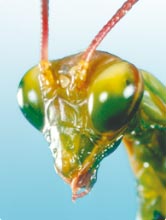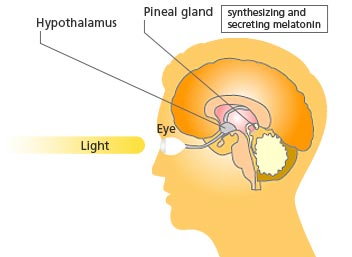Have you ever come across the expression “the third eye?” It refers to an additional eye positioned between the two eyes. In some religions, deities are said to possess them. In fact, however, our ancestors also had a third eye. Even today, what remains of this eye still senses light and plays a role in regulating our daily rhythm.
The third eye

Statue of Shiva seated on a tiger skin and accompanied by a cobra.
© Alamy / PPS
The Hindu deity Shiva is known as the deity of destruction and regeneration. The third eye on his forehead adds to his impressive appearance. It is said that when Shiva grows angry, flames shoot out of this third eye.
For Hindus, it is customary to place a mark where the third eye should be on the forehead. The “bindi” is worn as a charm against evil by women. Recently, bindi have become rather fashionable—some are even available in the form of plastic stickers. There is also a red powder used widely in India known as “sindoor” that is applied to the parting in a married woman's hair. Once the groom has applied this to the bride's hair at their wedding ceremony, she is expected to continue to use it everyday. This red powder, which is applied vertically as a red line at the position of the third eye, is worn by the wife as a way of showing that she is married. It is a custom that persists in rural areas.
Distinct third eyes can also be observed on Buddha statues influenced by Hinduism.
However, the third eye is not solely a religious concept.
The “eye” inside the brain

The “third eye” of the mantis. The parietal eye is located between the antennae.
© Photo Researchers / PPS
Certain lacertilian species such as the lacertid, and insects such as the mantis, possess a third eye, known as the parietal eye. Like the other two eyes, the parietal eye has a crystalline lens and a retina. Although it is unable to capture images, it is believed that it senses light and regulates body temperature and hormonal balance.
Amazingly, our distant ancestors also possessed a third eye, a trace of which still exists within our brains. Although this organ, known as the pineal gland, is located in the brain, at the cellular level it is astonishingly similar to the eye—particularly to the cellular structure of the retina. When the human embryo is in the earliest stage of development, the cells that will form the pineal gland have the potential (known as the differentiation potential) to become eye cells, such as lens, epithelial layer, or retina neuron cells. In short, although the pineal gland could turn into an eye, it instead develops into an organ that is completely different from the eye.
“An organ of extreme perfection and complication.”
So Charles Darwin, the originator of the Theory of Evolution, described the eye. And he remarked “I freely confess, absurd in the highest degree,” when attempting to explain the eye, with its incomparable construction, using the Theory of Evolution. How the eye could have been formed is both fascinating and extremely puzzling.
The animal eye was perfected very early on in the process of evolution. The eye of the fish and the human eye differ little in terms of the way in which they originated, and resemble one another in structure. However, the development of the pineal gland has varied enormously during the process of evolution from fish to human. Why has the eye and the pineal gland developed in such different ways—despite sharing the same potential when they were initially created? This question has fascinated Professor Masasuke Araki of Nara Women's University, a specialist in the biology of neural development, who has been engaged in research of the eye for many years. Although answering this question was seen as essential to discovering how the eye was formed, there had been little research done to achieve this.
Approximately 20 years of detailed experimentation by Professor Araki has revealed that the special environment within the brain enables cells that could form eyes to instead form the pineal gland. It has been learned that it is the effect of the brain's very structure as well as the effect of the peripheral nerves on the cells that cause them to form a pineal gland instead of an eye.
Why, however, do the cells of the pineal gland have this potential to form an eye in the first place? The answer to this question lies with our one-eyed ancestor.
Our one-eyed ancestor

An ancestor of the vertebrates (humans included), the lancelet has only one eye.
© Photo Researchers / PPS
If we trace our ancestry back through time, we will eventually come across a creature known as the lancelet. This primitive creature, which still exists today, is extremely simple in structure. Noteworthy is the fact that it has only one eye.
What is the significance of the fact that our ancestor had only one eye?
When considering the evolution of the eye, it is necessary to consider the evolution of the brain, which is very closely tied to the eye.
In many creatures, the brain is separated into left and right halves. In humans, the left hemisphere of the brain controls language. Going back to the start of the process of evolution, however, the brain was not in this form. The primitive brain, probably a solid mass, divided into left and right to assume its current form. Even today, the precise nature of this evolution is not well understood.
Even with a single eye, it is possible to see images. However, creatures with two eyes enjoy better depth perception and can gauge the distance of a visible object. As evolution progressed, the eye divided into left and right, as did the brain. It is not known whether the brain divided because the eye needed to evolve or whether it was the other way round. Whatever the case may be, the eye and the brain (although originally single, solid objects) both divided into right and left parts in the course of evolution.
Herein lies the answer to the question of how the third eye was created.
The eye that beats out a rhythm

The pineal gland senses light and secretes melatonin according to light stimulus received through the eyes and from the skin, which regulates the day-and-night rhythm.
Professor Araki believes that the third eye came into being during the transition from one eye to two. In other words, when the single eye was pulled to the left and right, and divided, an eye remained in the spot where the single eye had originally been. Thus, the third eye was not the third to be created, but the very first, and original.
Even more interesting is the fact that the pineal gland of a bird not only senses light but also plays a contributory role in the biological clock (or circadian clock), which beats out the body's daily rhythm.
In humans, the pineal gland no longer works as a biological clock, as the hypothalamus plays the part instead. The human pineal gland regulates the rhythm that beats out the biological clock by secreting a substance known as melatonin according to light stimulus received through the eyes and from the skin. In the morning, the level of melatonin secreted is low; in the evening, it is high. The benefit of exposure to natural light in the morning is that the secretion of melatonin is curbed, enabling the body to keep its daily rhythm on track.
It has recently been learned that many types of human cells other than the eyes and the skin possess light-sensing capabilities. When these cells are cultured, they mark out a rhythm independently. It is the role of the pineal gland and the hypothalamus to unite and manage them correctly—like a control tower for the biological clock. The third eye is, in a way, directing certain bodily functions.
Our ancestors only had one eye, which at some point divided into separate left and right eyes. It is believed that an eye remained in the place where the original single eye had been, known as the “third eye.“ This third eye evolved independently into the pineal gland, becoming the controller of the vital function of the biological clock. This story of the pineal gland's evolution is today firing the imaginations of researchers.
Editorial contributor / Date of article posted
Professor Masasuke Araki, Nara Women's University / February 2007

